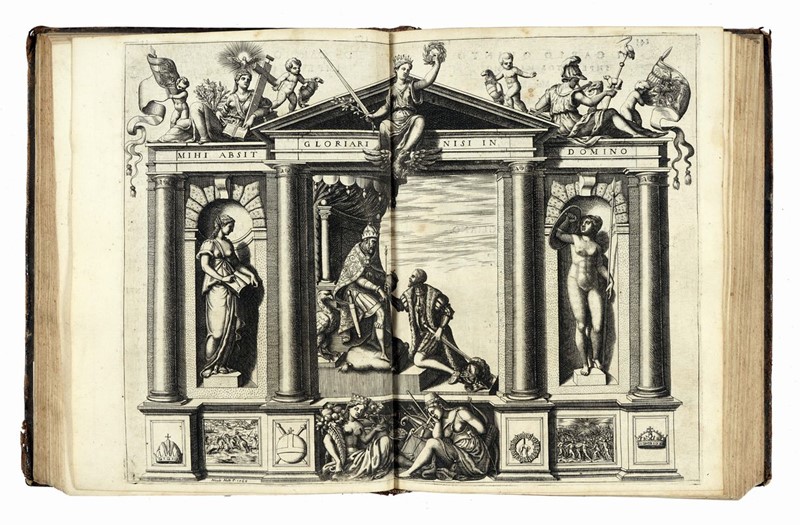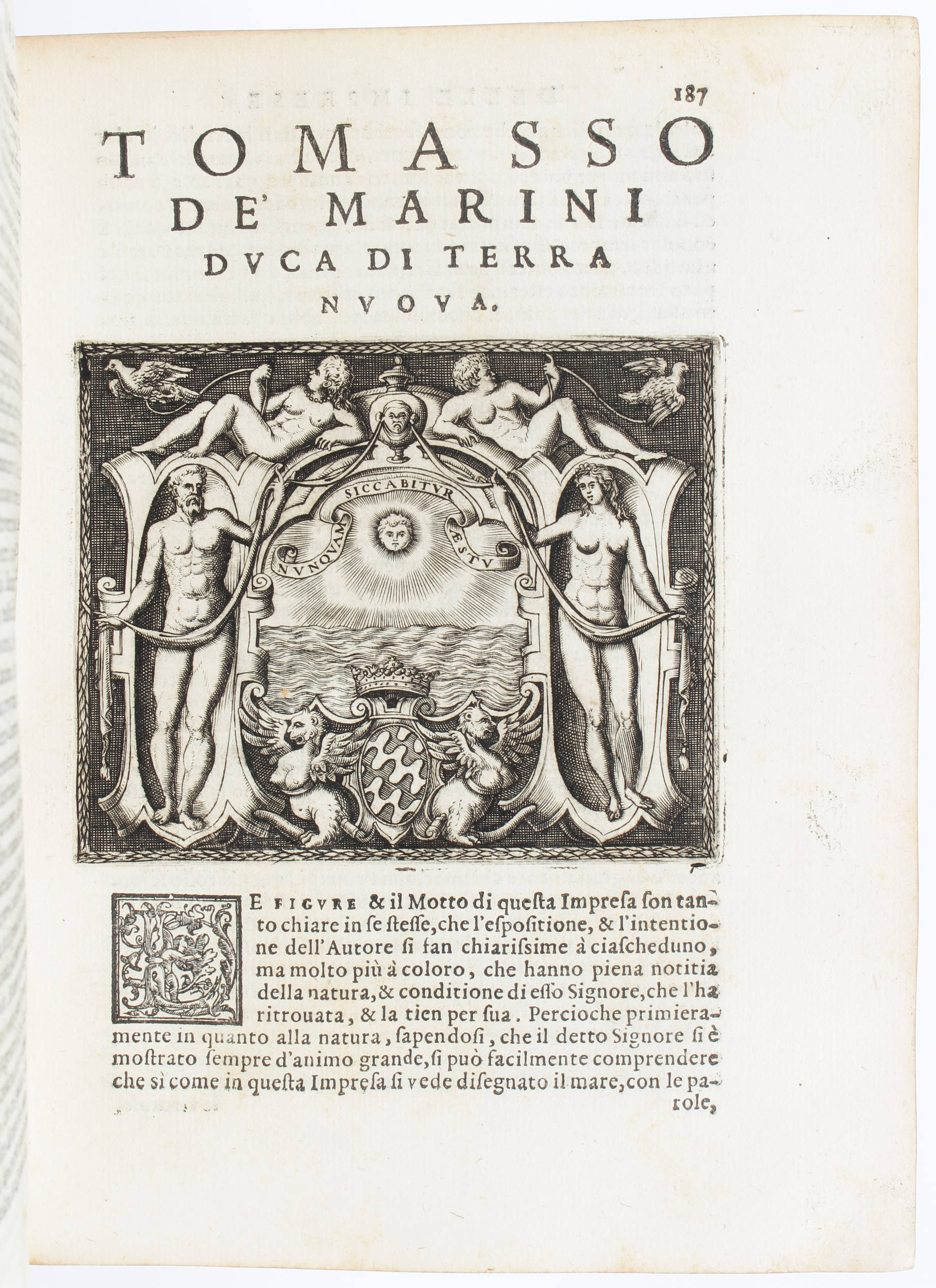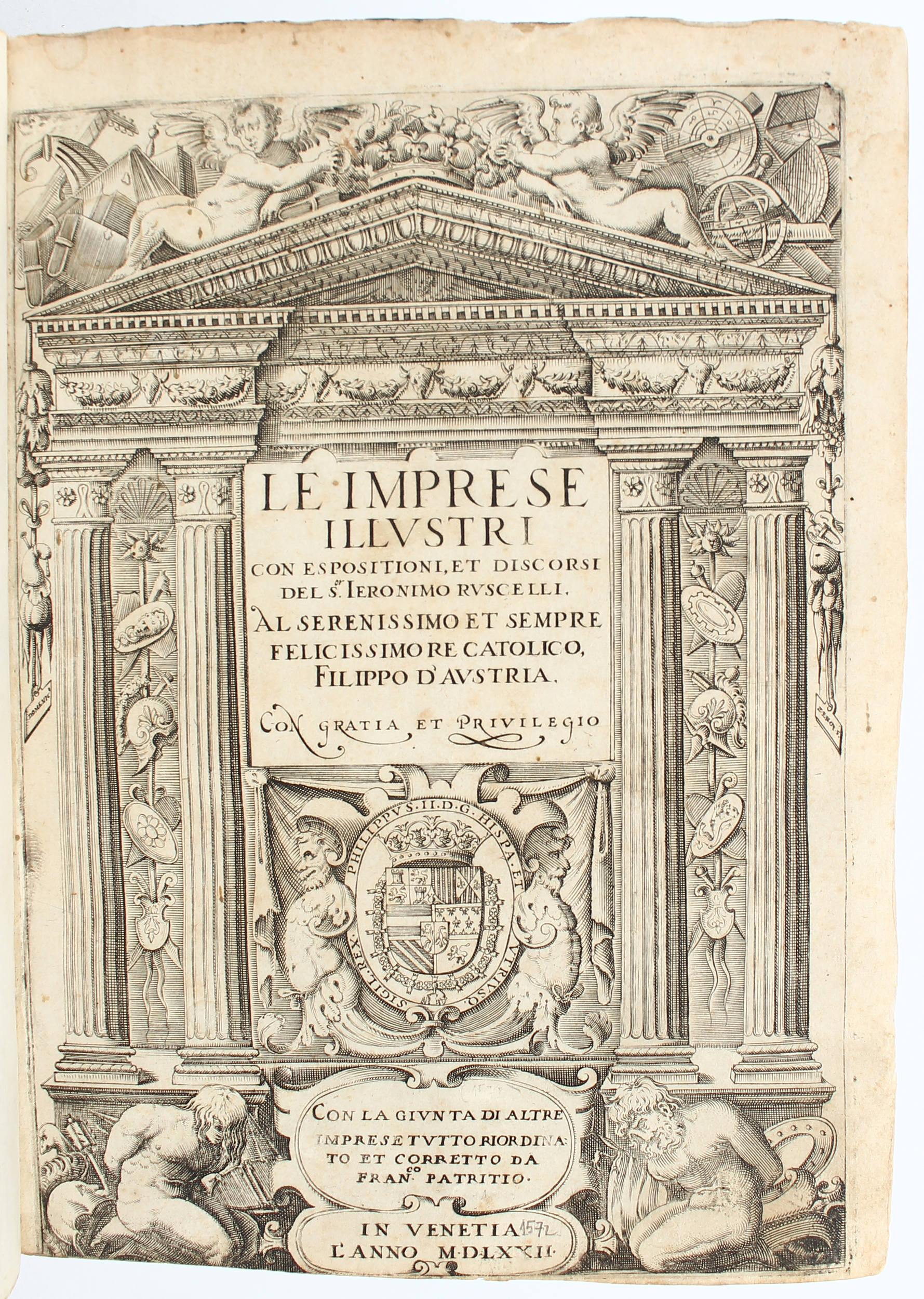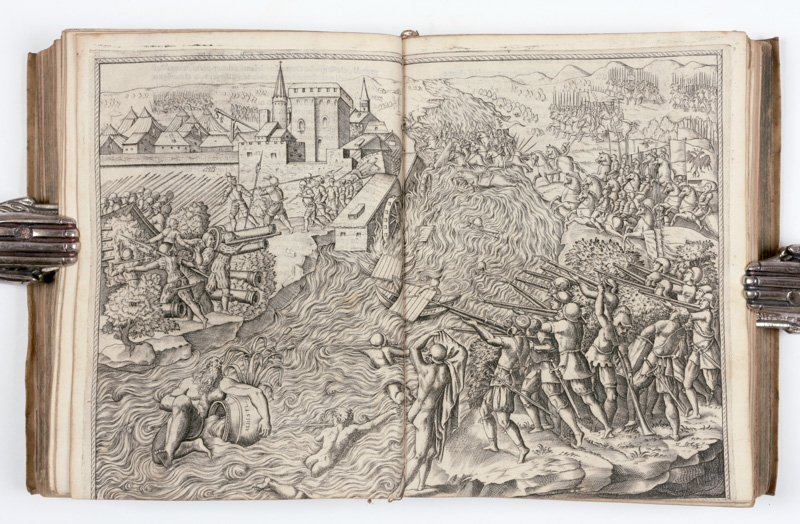Ruscelli, Girolamo. Le imprese illustri con espositioni, et discorsi del s.or Ieronimo Ruscelli. Al serenissimo et sempre felicissimo re catolico, Filippo d’Austria … Con la giunta di altre imprese tutto riordinato et corretto da Fran.co Patritio. Venice: Comin da Trino, 1572
Second edition of Ruscelli’s lavishly illustrated collection of emblems, revised by the Istrian scholar Francesco Patrizi (Franjo Petriš or Frane Petrić; 1529–1597). The author’s dedication to Felipe II (subscribed at Venice, 1 May 1566) is reprinted, however Patrizi replaced Ruscelli’s address to the reader with one of his own, in which he recounts the steady decline of Ruscelli’s health as he completed the text, which ended with his death. He rearranged the devices (Ruscelli had presented them in alphabetical order, according to the given name of the owner), and excised a lengthy “Epitalamio” for the deceased Queen of Spain (3 October 1568). Patrizi’s principal contributions are an unsigned engraved portrait of Ruscelli (†4v); a full-page engraving (BB4v) with lengthy explication, in prose and verse, of the impresa of the bibliophile Alfonso II del Carretto, Marchese di Finale—10 ff., on interpolated quires signed ccc–ddd4 ee2, and seemingly an afterthought—; a full-page engraving with explication of the impresa of Gonzalo Zativo (SSS1v–SSS2v); and two smaller engravings (BBBB1v, CCCC1v) with explications of imprese of Zaccaria Mocenigo, his former pupil. The fine engravings, by Niccolò Nelli Gaspare Osello, and Domenico Zenoi are restruck from the original plates, with one substitution and several omissions (see Mortimer, Italian, p.621).
Although Patrizi had acquired a fine humanistic education, at Ingolstadt and Padua, he struggled to find a satisfactory employment, and after drifting between a series of patrons—Giorgio Contarini, Filippo Mocenigo, Diego Hurtado de Mendoza—turned to the book trade, eventually selling a collection of seventy-five Greek manuscripts he had purchased in Cyrpus to Felipe II for his Escorial library. In August 1571, Patrizi contracted with an otherwise unknown Dionora Pugliese to publish this new edition of Ruscelli’s Le imprese illustri. Their partnership was fraught with extraordinary intrigues and lawsuits. In 1573, Patrizi founded his own publishing house (all’Elefanta), which collapsed after three editions, one of which was illustrated by his nephew Giacomo Franco In 1577, he was given a chair at Ferrara university, but soon became involved in scientific and literary controversy. Moving to Rome, in 1592, he spent the last years of his life embroiled in conflict with the Roman Inquisition.
3 parts in one volume, 4to (230 x 165 mm). Roman type, 43 lines plus headline. collation: †4 A–Z4 AA–ZZ4 AAA–BBB4 ccc–ddd4 ee2 CCC–ZZZ4 AAAA–CCCC4: 302 leaves. Engraved title, 2 engraved section-titles, full-page engraved portrait of Ruscelli, one full-sheet (LL2v–LL3r; depicting the Battle of Muhlberg, folded and preserving deckle at the fore-edges), 18 full-page, 96 half-page, and 16 smaller engravings of emblematic devices, many depicted within complex historiated architectural scroll-work (all printed with the text), save for the Battle of Muhlberg all colored by a contemporary hand (mostly in full, some towards the end of the volume in part), cancel engraving (with colored impresa) on D4v. (Some marginal dampstaining, light browning, and finger-soiling.)
binding: French limp vellum (236 x 170 mm), ca. 1572, single gilt fillet around sides, large oval gilt arabesque medallion in center of covers, flat spine, 6 false bands formed by double fillets, azured bud and leaves in compartments, vellum manuscript leaf as spine support, edges gilt. (Some staining, spine ends repaired.)
provenance: “Henry Simpiot” (Simprot? Limprot?; unidentified inscription on upper endleaf) — Lathrop C. Harper Inc., New York (1974) — Arthur Vershbow (1922–2012) and Charlotte Vershbow (1924–2000) (joint exlibris; Christie’s, New York, 20 June 2013, lot 681 ($8125). acquisition: Purchased at the Vershbow sale through Robin Halwas.
references: Edit16 24805; USTC 853913. For Patrizi’s short-lived partnership with Dionora Pugliese, see Marciani, “Un filosofo del Rinascimento editore-libraio: Francesco Patrizio e l’incisore Giovanni Franco di Cherso,” in La Bibliofilía 72 (1970), pp. 177–198 (pp. 185–188); Marciani, “Ancora su Francesco Patricio e Giovanni Franco,” in La Bibliofilía 72–73 (1970–1971), pp. 303–313 (pp. 303–305).
Ruscelli, Girolamo. Le imprese illustri con espositioni, et discorsi del s.or Ieronimo Ruscelli. Al serenissimo et sempre felicissimo re catolico, Filippo d’Austria … Con la giunta di altre imprese tutto riordinato et corretto da Fran.co Patritio. Venice: Comin da Trino, 1572
Second edition of Ruscelli’s lavishly illustrated collection of emblems, revised by the Istrian scholar Francesco Patrizi (Franjo Petriš or Frane Petrić; 1529–1597). The author’s dedication to Felipe II (subscribed at Venice, 1 May 1566) is reprinted, however Patrizi replaced Ruscelli’s address to the reader with one of his own, in which he recounts the steady decline of Ruscelli’s health as he completed the text, which ended with his death. He rearranged the devices (Ruscelli had presented them in alphabetical order, according to the given name of the owner), and excised a lengthy “Epitalamio” for the deceased Queen of Spain (3 October 1568). Patrizi’s principal contributions are an unsigned engraved portrait of Ruscelli (†4v); a full-page engraving (BB4v) with lengthy explication, in prose and verse, of the impresa of the bibliophile Alfonso II del Carretto, Marchese di Finale—10 ff., on interpolated quires signed ccc–ddd4 ee2, and seemingly an afterthought—; a full-page engraving with explication of the impresa of Gonzalo Zativo (SSS1v–SSS2v); and two smaller engravings (BBBB1v, CCCC1v) with explications of imprese of Zaccaria Mocenigo, his former pupil. The fine engravings, by Niccolò Nelli Gaspare Osello, and Domenico Zenoi are restruck from the original plates, with one substitution and several omissions (see Mortimer, Italian, p.621).
Although Patrizi had acquired a fine humanistic education, at Ingolstadt and Padua, he struggled to find a satisfactory employment, and after drifting between a series of patrons—Giorgio Contarini, Filippo Mocenigo, Diego Hurtado de Mendoza—turned to the book trade, eventually selling a collection of seventy-five Greek manuscripts he had purchased in Cyrpus to Felipe II for his Escorial library. In August 1571, Patrizi contracted with an otherwise unknown Dionora Pugliese to publish this new edition of Ruscelli’s Le imprese illustri. Their partnership was fraught with extraordinary intrigues and lawsuits. In 1573, Patrizi founded his own publishing house (all’Elefanta), which collapsed after three editions, one of which was illustrated by his nephew Giacomo Franco In 1577, he was given a chair at Ferrara university, but soon became involved in scientific and literary controversy. Moving to Rome, in 1592, he spent the last years of his life embroiled in conflict with the Roman Inquisition.
3 parts in one volume, 4to (230 x 165 mm). Roman type, 43 lines plus headline. collation: †4 A–Z4 AA–ZZ4 AAA–BBB4 ccc–ddd4 ee2 CCC–ZZZ4 AAAA–CCCC4: 302 leaves. Engraved title, 2 engraved section-titles, full-page engraved portrait of Ruscelli, one full-sheet (LL2v–LL3r; depicting the Battle of Muhlberg, folded and preserving deckle at the fore-edges), 18 full-page, 96 half-page, and 16 smaller engravings of emblematic devices, many depicted within complex historiated architectural scroll-work (all printed with the text), save for the Battle of Muhlberg all colored by a contemporary hand (mostly in full, some towards the end of the volume in part), cancel engraving (with colored impresa) on D4v. (Some marginal dampstaining, light browning, and finger-soiling.)
binding: French limp vellum (236 x 170 mm), ca. 1572, single gilt fillet around sides, large oval gilt arabesque medallion in center of covers, flat spine, 6 false bands formed by double fillets, azured bud and leaves in compartments, vellum manuscript leaf as spine support, edges gilt. (Some staining, spine ends repaired.)
provenance: “Henry Simpiot” (Simprot? Limprot?; unidentified inscription on upper endleaf) — Lathrop C. Harper Inc., New York (1974) — Arthur Vershbow (1922–2012) and Charlotte Vershbow (1924–2000) (joint exlibris; Christie’s, New York, 20 June 2013, lot 681 ($8125). acquisition: Purchased at the Vershbow sale through Robin Halwas.
references: Edit16 24805; USTC 853913. For Patrizi’s short-lived partnership with Dionora Pugliese, see Marciani, “Un filosofo del Rinascimento editore-libraio: Francesco Patrizio e l’incisore Giovanni Franco di Cherso,” in La Bibliofilía 72 (1970), pp. 177–198 (pp. 185–188); Marciani, “Ancora su Francesco Patricio e Giovanni Franco,” in La Bibliofilía 72–73 (1970–1971), pp. 303–313 (pp. 303–305).















Testen Sie LotSearch und seine Premium-Features 7 Tage - ohne Kosten!
Lassen Sie sich automatisch über neue Objekte in kommenden Auktionen benachrichtigen.
Suchauftrag anlegen